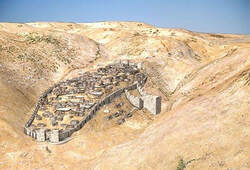Our feet have been standing within your gates, O Jerusalem.'
This is from Psalm 122 and is designated as ‘of David.’ If David actually penned it then when he speaks of the ‘house of the Lord’ he is speaking of the temporary tent he had erected at Gihon to house the ark of the Covenant—at the sacred spot known as HaMakom (The Place)—where he intended his son, Solomon to erect the Temple.
It’s also possible that David was envisaging the Temple because, as we are told in 1 Chronicles 28:2 he had it in his heart to build a house of rest for the ark of God. So much so that he had even drawn the plans—see verse 11 etc.
Whatever the case, the Temple is here described as being WITHIN the confines of the ‘compact’ city (verse 3) with the Temple within its gates!
What the City of David looked like can be seen in the two artist’s impressions; the impression at left is how the City of David would have looked under occupation by the Jebusites; the one on the right showing it superimposed on a relatively modern photo of the southern Moriah ridge on which it stood.
The Psalm describes the city as the place where ‘thrones (plural) are set’ (v.5).
Why thrones plural? Because both the spiritual and the civil thrones were there; God was enthroned as KING there above the ark and between the wings of the cherubim, but the earthly king, David also had his throne within the compact city!
Similarly, the psalmist speaks of ‘palaces’ plural, within this compact city (v.7) because there was both his and God’s.
In David’s time, the city that bore his name and which he had won from the Jebusites, occupied the neck or ridge of land which formed part of Moriah’s bulk and was bounded on the east by Kidron Valley and on the South and West by the valleys Hinnom and Tyropeon (Cheesemakers).


 RSS Feed
RSS Feed
